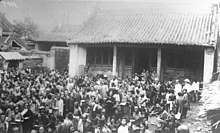Flood disaster in China in 1931
The 1931 flood disaster in China was a series of floods in the Yangtze River basin in the Republic of China . It is one of the most casualties of the recorded natural disasters. Estimates of the number of victims range from 145,000 to 3.7 million.
procedure
From 1928 to 1930, China experienced a long drought. In the late winter of 1930, heavy snowstorms broke out in central China. The river levels rose sharply as a result of the subsequent thaw and heavy rainfall. In July and August 1931 the rain became heavier. In 1931 there was also extreme cyclonic activity . In July alone, nine cyclones hit the region, while there are only two on average over the entire year.
The peak of the flood was on the Yangtze in July and August 1931. For July alone, four weather stations along the river recorded a total of 600 mm of rain.
The tidal wave of the Yangtze River and the Huai He connected to it soon reached Nanjing , then the capital of China. The city, located on an island in the floodplain of the river, suffered catastrophic damage. Numerous people drowned, others died of starvation or as a result of epidemics such as cholera and typhus . Desperate residents sold their wives and daughters, and reports to the government reported cases of infanticide and cannibalism . The flood affected , among others, Hubei , Hunan , Jiangxi , Wuhan and Chongqing .
On August 19, the water level at Hankou in Wuhan reached 16 meters above normal. On the evening of August 25, 1931, the water flowing through the Imperial Canal broke through the dikes near Lake Gaoyou . About 200,000 people were surprised in their sleep and drowned.
Chinese sources give the number of deaths usually around 145,000, 28.5 million people were affected by flood damage. Most western sources put the number of deaths at around 3.7 million.
Government reactions
In the wake of the flood, the Kuomintang government set up organizations such as the Huai River Conservancy Commission to address the flood issue. Because of a lack of funds and the turmoil of the Second Sino-Japanese War and the Chinese Civil War , the various commissions were only able to build small dams along the Yangtze.
After the end of the civil war, the communist party leader Mao Zedong traveled to the Yangtze in 1953 to support the construction of the Three Gorges Dam . According to him, the project should outperform other major projects in Chinese history such as the Great Wall and the Imperial Canal.
Scientists and officials who expressed doubts, such as Chen Mingshu , were persecuted as "rights" as part of the Communist Party's "purges". Well-known scientist and minister of geological resources, Li Siguang , told Mao that he would commit suicide if he could not prevent the dam from being built. The project did not get beyond the planning stage during Mao's lifetime. A lack of resources, the growing tensions with the Soviet Union and the catastrophic consequences for the economy and unrest as a result of the so-called "Great Leap Forward" contributed to this. Construction began in the 1980s and was completed in 2012.
Individual evidence
- ↑ a b c d e f g h i j Pietz, David (2002). Engineering the State: The Huai River and Reconstruction in Nationalist China 1927–1937 . Routledge. ISBN 0-415-93388-9 . P. Xvii, pp. 61-70.
- ↑ a b 中国 水利 网 (Chinese) ( Memento of the original from June 25, 2006 in the Internet Archive ) Info: The archive link was inserted automatically and has not yet been checked. Please check the original and archive link according to the instructions and then remove this notice. . Chinawater.com.cn. Retrieved November 13, 2012.
- ↑ a b c d Mickey Glantz, Michael H. Glantz: Climate Affairs: A Primer. Island Press 2003. ISBN 1-55963-919-9 . P. 252.
- ^ "NOAA'S top global weather, water and climate events of the 20th century" . NOAA.gov. December 13, 1999. Retrieved November 29, 2012.
- ^ Simon Winchester : The River at the Center of the World: A Journey Up the Yangtze, and Back in Chinese Time . Macmillan 2004. ISBN 0-312-42337-3 .
- ↑ a b c d Cheng Li, Arthur Doak Barnett: Rediscovering China: Dynamics and Dilemmas of Reform . Rowman & Littlefield 1997. ISBN 0-8476-8338-9 . Pp. 168-169.
- ↑ Breathtaking force: World's most powerful dam opens in China as gushing water generates the same power as FIFTEEN nuclear reactors . In: The Daily Mail . July 25, 2012. Retrieved September 13, 2012.
